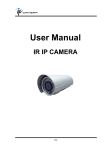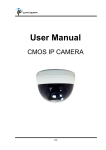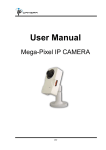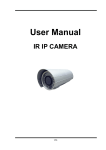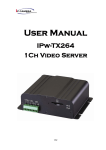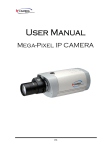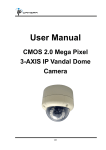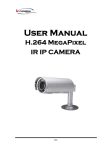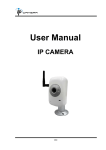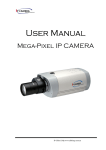Download P416 User`s Manual
Transcript
PiXORD Pan/Tilt/Zoom IP Camera P416 (W) User’s Manual Version: 1.0 Date: 09/05/2008 WARINGS TO REDUCE THE RISK OF FIRE OR ELECTRIC SHOCK, DO NOT EXPOSE THIS PRODUCT TO RAIN OR MOISTURE. DO NOT INSERT ANY METALLIC & ELETRIC CONDUCTIVE OBJECT THROUGH VENTILATION GRILLS. CAUTION CAUTION RISK OF ELECTRIC SHOCK DO NOT OPEN CAUTION:TO REDUCE THE RISK OF ELECTRIC SHOCK. DO NOT REMOVE COVER (OR BACK). NO USER-SERVICEABLE PARTS INSIDE. REFER SERVICING TO QUALIFIED SERVICE PERSONNEL. COPYRIGHT THE TRADEMARKS MENTIONED IN THE MANUAL ARE LEGALLY REGISTERED TO THEIR RESPECTIVE COMPANIES. 1 CONTENTS CHAPTER 1 PREFACE .................................................................................................................................................. 3 CHAPTER 2 PRODUCT SPECIFICATIONS............................................................................................................... 4 CHAPTER 3 PRODUCT INSTALLATION .................................................................................................................. 6 1. MONITOR SETTING ................................................................................................................................................ 6 2. HARDWARE INSTALLATION.................................................................................................................................... 7 3. IP ASSIGNMENT ..................................................................................................................................................... 8 4. INSTALL ACTIVEX CONTROL ............................................................................................................................... 10 CHAPTER 4 LIVE VIDEO ........................................................................................................................................... 12 CHAPTER 5 IP CAMERA CONFIGURATION ......................................................................................................... 14 1. SYSTEM ............................................................................................................................................................... 14 2. NETWORK ........................................................................................................................................................... 18 3. A/V SETTING....................................................................................................................................................... 24 4. EVENT LIST ......................................................................................................................................................... 30 CHAPTER 6 NETWORK CONFIGURATION .......................................................................................................... 34 CHAPTER 7 I/O CONFIGURATION.......................................................................................................................... 36 CHAPTER 8 FACTORY DEFAULT .......................................................................................................................... 38 APPENDIX A LIST OF COMPATIBLE SD ................................................................................................................ 39 2 Chapter 1 Preface This IP Camera is a Pan/Tilt/Zoom IP camera. It has the web server built in. User can view real-time video via IE browser. IP Camera supports simultaneously MPEG-4&JPEG video compression and dual streaming which provides smooth and high video quality. The Pan/Tilt/Zoom function can be controlled remotely. The video can be stored in the SD card, and playback remotely. With user friendly interface, it is an easy-to-use IP camera which is designed for security application. 3 Chapter 2 Product Specifications z z z z z z Pan/Tilt/Zoom remote control z z z z 2-way audio IR Cut Filter (ICR) Support dual streaming MPEG4&JPEG compression Supports SD card for local recording Wireless network connection﹝Optional﹞ Support Cell Phone/PDA Support 3GPP Online firmware upgrade Specifications Hardware CPU ARM 9, 32 bit RISC SDRAM 64MB Flash 8MB Image sensor 1/4” CCD Lens Type Auto Focus zoom lens Video Out 1-ch RCA type (CBVS Monitor output) Audio in/ out 1 in/ 1 out (3.5 mm Phone Jack ) Alarm I/O 1 in/ 1 out Pan angle 270° Tilt angle 120° Zoom ratio 12X optical zoom Focal length F(wide)3.8 to f(tele) 45.6mm Power Consumption LAN : DC 5V, 1.7A / WLAN : DC 5V, 1.9A Dimensions (W×H×D) 105x157x105 mm Network Ethernet 10/ 100 Base-T Wireless 802.11b/g (Optional) 4 WEP 64/ 128 bit Network Protocol HTTP, TCP/ IP, UDP, SMTP, FTP, PPPoE, DHCP, DDNS, NTP, 3GPP, UPnP System NTSC:720x480, 704x480, 352x240, 176x120 Video Resolution PAL :720x576, 704x576, 352x288, 176x144 Video adjust Brightness, Contrast, Saturation, Hue Dual Streaming Yes Image snapshot Yes Full screen monitoring Yes Preset Point 9 Patrol Yes (once) Auto Pan Yes (once) Pan/Tilt/Zoom control Yes Compression format MPEG-4/ JPEG Video bitrate adjust CBR, VBR Motion Detection Yes, 3 different areas Triggered action Mail, FTP, Save to SD card Pre/ Post alarm Yes, configurable Security Password protection Firmware upgrade HTTP mode, can be upgraded remotely Simultaneous connection Up to 10 Audio Yes, 2-way SD card management Recording trigger Motion Detection, IP check, Network status (Wire Connection only) Video format AVI,JPEG Video playback Yes Delete files Yes Web browsing requirement OS Hardware Windows 2000, XP, 2003, IE 6 or above Suggested Intel-C 2.0G, RAM:512MB, Graphic card:64MB Minimum Intel-C 1.6G, RAM:256MB, Graphic card:32MB 5 Chapter 3 Product Installation 1. Monitor Setting I. Right-Click on the desktop. Select “ Properties”. II. Change color quality to highest (32bit). 6 2. Hardware Installation I. Connect power adaptor II. Connect IP Camera to PC or network with Ethernet cable III. Connect IP Camera to PC or network IV. Set up the network configurations according to the network environment. For further explanation, please refer to chapter VI, “Network Configuration for IP Camera”. V. Back Panel for your reference 7 3. IP Assignment IP Installer is a utility that provides an easier, more efficient way to configure the IP address and network settings of the network camera. It even provides a convenient way to set the network settings for multiple devices simultaneously using the batch setting function. Moreover, IP Installer can save the network settings for all devices as a backup and restore them when necessary. z Always consult your network administrator before assigning an IP address to your server in order to avoid using a previously assigned IP address. z z Ensure the network camera is powered on and correctly connected to the network. MAC Address: Each network camera has a unique Ethernet address (MAC address) shown on the sticker of the camera. z One final note, although the IP Installer is able to find and configure any network camera on the LAN except those that are behind a router, it is a good idea to set the host PC to the same subnet. In order to connect to the Web-based user interface of the network camera, the host PC must be in the same subnet. For more information about subnets, please consult your network administrator. 1. Use the software, “IP Installer” to assign an IP address for the camera device. The software is in the attached software CD. 2. Click “IP Installer” from the CD menu to start the installation. 3. Once IP Installer has been successfully installed on the computer, double click the IP Installer icon on the desktop, or select it from Start > Programs > PiXORD Corporation > IP Installer > IP Installer. 4. The IP Installer window is displayed below. Click the menu bar Tool > Search Network Device to search the network camera in the LAN. 5. From the list, select the device with the MAC Address that corresponds to the device that is to be configured. 6. Double click the item to open the Property Page dialog box for the selected device or click the menu bar View > Property. 8 7. After filling in the properties, click [Synchronize] button to complete the configuration settings and save in the network camera and PC immediately. If click [OK] button, the configuration is only be saved in the PC. 8. To access the Web-based UI of the selected unit, run the View > Open Web on the menu bar. 9. If the device has been configured correctly, the default Web browser will open to the home page of the selected device. 9 4. Install ActiveX control For the first time to view the camera video via IE, it will ask you to install the ActiveX component. If the installation failed, please check the security setting for the IE browser. I. IE Æ Tools Æ Internet Options… Æ Security Tab Æ Custom Level… Æ Security Settings Æ Download unsigned ActiveX controlsÆ Select “Enable” or Prompt. II. IE Æ Tools Æ Internet Options… Æ Security Tab Æ Custom Level… ÆInitialize and script ActiveX controls not marked as safe Æ Select “Enable” or Prompt. 1 2 3 4 10 5 When popup the following dialogue box, click “Yes”. 11 Chapter 4 Live Video Start an IE browser, type the IP address of the IP Camera in the address field. It will show the following dialogue box. Key-in the user name and password. The default user name and password are “admin” and “admin”. When connect to the IP Camera ,The following program interface shows. 13 14 1 2 6 3 4 5 7 8 9 11 12 10 17 12 15 16 1. Pan Tilt control of this IP camera 2. Auto Pan:The camera will pan horizontally. 3. Patrol:The camera will move alone with the preset points. 4. Zoom : Digital zoom in/out 5. Focus: Manually 6. Speed:The speed of the camera move. 7. List of preset points 8. Edit name for each preset point 9. Languages: Select a language for the interface. Currently 4 languages can be selected; English, Traditional Chinese, Simplified Chinese and French. 10. Display the video image in actual size. 11. Video snapshot 12. Get into the administration page. 13. Select video streaming source (When streaming 2 setting in『Video Setting』 is closed, this function will not display) 14. IP Camera supports 2-way audio. Click the “Chatting” check box. Then you can use microphone which connects to the PC to talk to server side, which is IP Camera side. 15. Control the relay which is connected to this camera. 16. Shows how many people connect to this IP camera 17. Show system time, video resolution, and video refreshing rate Double-click the video, it will change to full screen mode. Press “Esc” or double-click the video again, it will change back to normal mode. Right-Click the mouse on the video, it will show a pop-up menu. 1. Snapshot:Save a jpg picture 2. Record Start:Record video in the local PC. It will ask you where to save the video. To stop recording, right-click the mouse again. Select “Record Stop”. The video format is AVI. Use Microsoft Media Player to play the recorded file. 3. Mute:Turn of the audio. Click again to turn on it. 4. Full Screen:Full-screen mode. 5. Zoom: Launch digital zoom function 13 Chapter 5 IP Camera Configuration Click Configuration to get into the administration page. Click Live Video to back to the live video page. 1. System i. System Information a. Server Information:Set up the camera name, select language, and set up the camera time. 1. Server Name:This is the Camera name. This name will show on the IP Installer. 2. Select language:There are English, Traditional Chinese, and Simple Chinese to select. When changed, it will show the following dialogue box for the confirmation of changing language. 14 b. OSD Setting:select a position where date & time display on screen. c. Server time setting:Select options to set up time - “NTP”, “Synchronize with PC’s time”, “Manual”, “The date and time remain the same”. 15 ii. User Management IP Camera supports three different users, administrator, general user, and anonymous user. a. Anonymous User Login: Yes:Allow anonymous login No:Need user name & password to access this IP camera b. Add user: Type the user name and password, then click “Add/Set”. c. Click “edit” or “delete” to modify the user. 16 iii. System update: a. To update the firmware online, click “Browse…” to select the firmware. Then click “Upgrade” to the proceed. b. Reboot system:re-start the IP camera c. Factory default:delete all the settings and restore defaults system. d. Setting Management:User may download the current setting to PC, or upgrade from previous saved setting. 1. Setting download: Right-click the mouse button on Setting Download Æ Select “Save AS…” to save current IP CAM setting in PC Æ Select saving directory Æ Save 2. Upgrade from previous setting Browse Æ search previous setting Æ open Æ upgrade Æ Setting update confirm Æ click index.html. to return to main page 17 2. Network i. IP Setting The camera supports DHCP and static IP. a. DHCP:Using DHCP, camera will get all the network parameters automatically. b. Static IP:Please type in IP address, subnet mask, gateway, and DNS manually. c. Port Assignment: user may need to assign different port to avoid conflict when setting up IP assignment. 1. Web Page Port: setup web page connecting port and video transmitting port (Default: 80) 2. RTSP Port: setup port for RTSP transmitting (Default: 554) 3. RTP Start and End Port: in RTSP mode, you may use TCP and UDP for connecting. TCP connection uses RTSP Port (554). UDP connection uses RTP Start and End Port. d. UPnP This IP camera supports UPnP, If this service is enabled on your computer, the camera will automatically be detected and a new icon will be added to “My Network Places.” Note: UPnP must be enabled on your computer. Please follow the procedure to activate UPnP 1. open the Control Panel from the Start Menu 2. select Add/Remove Programs 18 ii. 3. Select Add/Remove Windows Components and open Networking Services section 4. Click Details and select UPnP to setup the service 5. The IP device icon will be added to “MY Network Places” 6. User may double click the IP device icon to access IE browser PPPoE: Select “Enabled” to use PPPoE. Key-in Username and password for the ADSL connection. Send mail after dialed:When connect to the internet, it will send a mail to a specific mail account. For the mail setting, please refer to “Mail and FTP” settings. iii. DDNS: Camera supports DDNS (Dynamic DNS) service. a. DynDNS: 19 1. Please enable this service 2. Key-in the DynDNS server name, user name, and password. 3. Set up the IP Schedule update refreshing rate. 4. Click “Apply” 5. If setting up IP schedule update too frequently, the IP may be blocked. In general, schedule update every day (1440 minutes) is recommended. 20 b. c. Camddns service: 1. Please enable this service 2. Key-in user name. 3. IP Schedule update is default at 5 minutes 4. Click “Apply”. DDNS Status 1. Updating:Information update 2. Idle:Stop service 3. DDNS registration successful, can now log by http://<username>.ddns.camddns.com:Register successfully. 4. Update Failed, the name is already registered:The user name has already been used. Please change it. 5. Update Failed, please check your internet connection:Network connection failed. 6. Update Failed, please check the account information you provide:The server, user name, and password may be wrong 21 iv. Wireless Setting (Wireless Network Optional) Supports 802.11 b/g wireless connection. Notice:Wireless network and Ethernet network use the same IP, the user has to unplug Ethernet cable, if Ethernet cable is not unplug, wireless setting can not be executed. a. Status of Wireless Networks: scan all wireless services. b. Wireless Setting: 1. Mode:There are Infrastructure and Ad-hoc. Infrastructure is for connecting with the router. Ad-hoc is for connecting with PC. There is “Channel” to select only when user uses Ad-hoc mode. e.g. If one PC’s channel is 1, the other’s channel has to be 1, too. 2. SSID:Based on AP setting. 22 3. Channel:This is used only when the user selects Ad-hoc mode in order to avoid conflict. 4. Security:It supports “None”, “WEP”, “WPA-PSK” security encryption based on the setting of the Router. 5. WEP: z Authentication:There are Open System and Shared Keys, it is based on different encryptions. This has to be the same as the Router’s setting. z Encryption:There are 64 bits and 128 bits. This is based on Key Type based on the Router’s setting. z Key Type:There are HEX and ASCII. When selecting HEX, the user only can input 0~9 characters and use A, B, C, D, E, and F. z z 6. When selecting ASCII, the user can input any character. (Case sensitive) Key 1~4:Based on Key Type to input characters. WPA-PSK: z z Encryption:There are TKIP and AES. Pre-Shared Key:Allow any characters. (Case sensitive) 23 3. A/V Setting i. Image Setting Image Setting: Adjust “Brightness”, “Contrast”, “Hue”, “Saturation” to get clear video. Zoom Setting: Adjust “White Balance”, “Shutter Speed”, “Sharpness”, and “IRIS Level” to get clear video. Note: When Shutter Speed is Auto, the IRIS Level is invalid. ii. Video setting User may select 2 streaming output simultaneously: Streaming 1 Setting: Basic mode and Advanced mode Streaming 2 Setting: Basic mode, Advanced mode, and 3GPP mode (Max Video Frame Rate for both streaming combined is 25 FPS) a. Streaming 1 Basic Mode: 24 1. Resolution: There are 4 resolutions to choose. 2. NTSC / PAL D1 – 720×480 / 720×576 4CIF – 704×480 / 704×576 CIF – 352×240 / 352×288 QCIF – 176×120 / 176×144 Quality: There are 5 levels to adjust: Best/ High/ Standard/ Medium/ Low The higher the quality is, the bigger the file size is. Also not good for internet transmitting 3. Video Frame Rate:The video refreshing rate per second. 4. Video Format:MPEG4 or JPEG. 5. RTSP Path: RTSP output name 25 b. Streaming 1 Advanced Mode: 1. Resolution: There are 4 resolutions to choose. 2. NTSC / PAL D1 – 720×480 / 720×576 4CIF – 704×480 / 704×576 CIF – 352×240 / 352×288 QCIF – 176×120 / 176×144 Bitrate Control Mode There are CBR﹝Constant Bit Rate﹞ and VBR﹝Variable Bit Rate﹞to use. CBR:32Kbps~4Mbps – Increase CBR to increase the picture qulity; vise versa VBR:1(Low)~10(High) – Compression rate, the higher the compression rate, the lower the picture quality is; vise versa. The balance between VBR and network bandwidth will affect picture quality. Please carefully select the VBR rate to avoid picture breaking up or lagging. 3. Video Frame Rate Picture display frame per second NTSC: Max 30 frames/second PAL: Max 25 frames/second 4. GOP Size It means "Group of Pictures". The higher the GOP is, the better the quality is. 5. Video Format: There are 2 Video Format to choose MPEG4 or JPEG. 6. RTSP Path: RTSP output connecting route 26 c. Streaming 2 Basic Mode: 1. Resolution: There are 4 resolutions to choose. 2. NTSC / PAL D1 – 720×480 / 720×576 4CIF – 704×480 / 704×576 CIF – 352×240 / 352×288 QCIF – 176×120 / 176×144 Quality: There are 5 levels to adjust: Best/ High/ Standard/ Medium/ Low The higher the quality is, the bigger the file size is. Also not good for internet transmitting 3. Video Format:MPEG4 or JPEG 4. RTSP Path: RTSP output connecting route d. Streaming 2 Advanced Mode: 27 1. Resolution: There are 4 resolutions to choose. 2. NTSC / PAL D1 – 720×480 / 720×576 4CIF – 704×480 / 704×576 CIF – 352×240 / 352×288 QCIF – 176×120 / 176×144 Bitrate Control Mode There are CBR﹝Constant Bit Rate﹞ and VBR﹝Variable Bit Rate﹞to use. CBR:32Kbps~4Mbps (the higher the CBR is, the better the video quality is) VBR:1~10 (Compression Rate) 3. Video Frame Rate The video refreshing rate per second. 4. GOP Size It means "Group of Pictures". The higher the GOP is, the better the quality is. 5. Video Format:MPEG4 or JPEG 6. RTSP Path: RTSP output name e. Streaming 2, 3GPP mode: 3GPP mode suggest setting: QCIF, lower than 128kbps, 5FPS, GOP= 1x FPS or 2x FPS, MPEG4 format 1. Fix Resolution: QCIF 2. – 176×120 / 176×144 Bitrate Control Mode 28 There are CBR﹝Constant Bit Rate﹞ and VBR﹝Variable Bit Rate﹞to use. CBR:32Kbps~320bps (the higher the CBR is, the better the video quality is) VBR:1~10 (Compression Rate) 3. Video Frame Rate ( 5 FPS is recommended ) The video refreshing rate per second. 4. GOP Size It means "Group of Pictures". The higher the GOP is, the better the quality is. i. 5. Video Format:MPEG4 or JPEG 6. 3GPP: 3GPP output name Audio: This IP camera supports 2-way audio. a. From IP camera to local PC, select “Enable” to start this function (When enabled, you can send audio via external mic in the IP Camera) b. For local PC to IP camera, check “chatting” in the browsing page (You will need a mic to send audio from local PC to IP Camera) The Audio will not be smooth when enable SD card recording function simultaneously. 29 4. Event List This IP Camera provides multiple event settings. i. Event Setting a. Motion Detection IP CAMERA allows 3 areas motion detection. When motion is triggered, it can send video to some specific mail addresses, transmit video to remote ftp server, trigger the relay, and save video to local SD card. To set up the motion area, click “Area Setting”. Using mouse to drag and set the area. The same operation for area 2 and 3. 30 b. Record File Setting: IP CAMERA allows 3 different types of recording file to change its record size. When motion/alarm is triggered, there are 3 different types of record mode. c. 1. AVI File (With Record File Setting ) 2. Multi-JPEG (With Record File Setting), only with JPEG compression format. 3. Single JPEG (Single File with Interval Setting) Record Time Setting:Pre Alarm and Post Alarm setups for video start and end time when motion detected, I/O, or other devices got triggered. Note: Pre/Post Alarm record time is base on record time setting and IP Cam built-in Ram memory. Limited by IP Cam built-in Ram Memory, When information is too much or video quality set too high, it will cause recording frame drop or decrease on post alarm recording time. d. Network Dis-connected When the network is down, it will save the video to local SD card. This function is only enabled in wire connection. e. Network IP check For the use of recording software, IP CAMERA supports the detection of network connection. Whenever the connection is down, it records the video to SD card. To use this function, key in the IP address of the PC which is installed in the recording software, and enable the function of “Save to SD card”, then click “Apply”. The interval of two video files on SD card is fixed with 30 seconds. ii. I/O Setting IP Camera supports 1 input/ 1 output. When input is triggered, it can send the video to some specific mail addresses, transmit the video to remote ftp server, trigger the relay, and save video to local SD card. 31 iii. Mail & FTP To send out the video via mail or ftp, please set up the configuration first. iv. SD card Please Insert SD card before use it. Make sure pushing SD card into the slot completely. Note:The use of the SD card will affect the operation of this IP camera slightly, such as affecting the frame rate of the video a. Playback: 32 1. It will show the capacity of the SD card. Click the date listed on this page. It will show the list of the video. 2. The video format is AVI. Click the video to start Microsoft Media Player to play it. 3. To delete the video, check it, then click Del. When the SD card is full, it will remove the oldest video automatically. v. Log List Sort by System Logs, Motion Detection Logs and I/O Logs. In addition, System Logs and I/O Logs won’t lose data due to power failure. 33 Chapter 6 Network Configuration i. Configuration 1: a. Internet Access:ADSL or Cable Modem b. IP address:One real IP or one dynamic IP c. Only this IP camera connects to the internet d. For fixed real IP, set up the IP into this IP camera. For dynamic IP, start PPPoE. ii. Configuration 2: a. Internet Access:ADSL or Cable Modem b. IP address:More than one real IP or one dynamic IP c. This IP Camera and PC connect to the internet d. Device needed:Switch Hub e. For fixed real IP, set up the IP into this IP camera and PC. For dynamic IP, start PPPoE. 34 iii. Configuration 3: a. Internet Access:ADSL or Cable Modem b. IP address:one real IP or one dynamic IP c. This IP Camera and PC connect to the internet d. Device needed:IP sharing e. Use virtual IP, set up port forwarding in IP sharing. 35 Chapter 7 I/O Configuration i. I/O Connection a. Please connect the G &O pin ( as above figure) to the external relay (buzzer) device. b. Please connect the G &I pin ( as above figure) to the external Trigger Device. ii. I/O Setup a. Click I/O Setting from the system setup page via IE, and check “Out1” to enable I/O signal. 36 b. Click ON/OFF from the setup main page via IE to control relay out signal. 37 Chapter 8 Factory Default i. To recover the default IP address and password, please follow the following steps. ii. Remove power, and press and hold the button in the back of IP Camera. iii. iv. v. vi. Power on the camera. Don’t release the button during the system booting. It will take around 30 seconds to boot the camera. Release the button when camera finishes proceed. Re-login the camera using the default IP (http://192.168.1.200), and user name (admin), password (admin). 38 Appendix A List of Compatible SD SD Card Recommended: SanDisk 128M SanDisk 256M SanDisk 512M SanDisk 1G SanDisk 2G SanDisk 4G Transcend 128M 80X Transcend 256M 80X Transcend 512M 80X Transcend 1G 80X Transcend 2G 80X Transcend 4G 80X 39








































